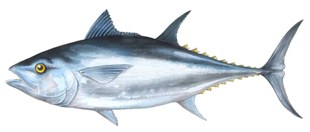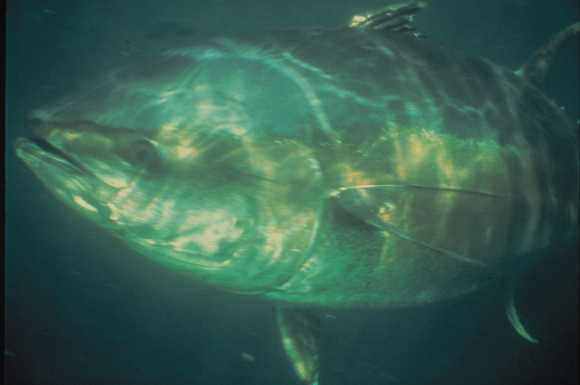Bluefin Tuna
Latin Name
Thunnus thynnus
Group Name
Pelagics
International management
The Atlantic Bluefin Tuna (Thunnus thynnus) is a large, highly migratory marine fish found across the Atlantic Ocean, Mediterranean and Black Seas. As such, they are managed internationally. In the Atlantic, the International Commission for the Conservation of Atlantic Tunas (ICCAT) is the regional fishery management organizations responsible for all tuna and tuna-like species. Under this type of management, all countries who participate in the fishery are brought together to ensure consistent management measures are being adopted.
Bluefin Tuna in the Atlantic has two stock units, an eastern Atlantic stock and a western Atlantic stock, and each unit's stock status is assessed separately. The total allowable catch (TAC) for each stock is agreed by consensus (from all participating countries) and then quotas are distributed to countries based on an allocation key (e.g. Canada receives 22.34% of the Western Atlantic TAC). Once quotas are allocated, each country is responsible for the management of their allotted quota. This includes the distribution of domestic quotas, collecting scientific data, management measures and enforcement.
Habitat
Atlantic Bluefin Tuna are highly migratory and can tolerate a wide range of temperatures. The western Atlantic Bluefin Tuna population feed during the summer in Atlantic Canadian waters and migrate south during the winter months to the Gulf of Mexico where their spawning, larval and juvenile rearing habitats are located. Their migration patterns are still not clearly defined, as new tagging data is proving that these animals not only migrate north (Canada) and south (Gulf of Mexico) but are also migrating west (Canada) to east (Mediterranean sea).
Atlantic Bluefin Tuna juveniles and adults are opportunistic feeders; however, in general, juveniles feed on crustaceans, fish and cephalopods, while adults primarily feed on fish such as herring, anchovy, sand lance, sardine, sprat, bluefish and mackerel.
Biological features
- Dark blue/black in colour with a light blue side and silvery grey underneath;
- Streamlined in shape, with two dorsal fins;
- The general life expectancy is 40 years;
- Bluefin Tuna can frequently dive to depths of more than 1,000 m;
- They can grow up to 331 cm long and can weigh up to 725 kg.
- Highly migratory (can travel up to 10,000km in a single year)
- Bluefin cannot breath unless they are swimming, therefore they are always moving
- Bluefin are unique in that they are warm blooded
- As a result of their long migration route, constant swimming and their need to regulate their body temperature, Bluefin have a very high metabolism which requires large amounts of prey to fulfill their metabolic needs
Threats
The largest threat to Atlantic Bluefin Tuna is considered to be fishing mortality, both targeted and incidental. In Canada, they are harvested commercially from the Scotian Shelf, St. Margaret's Bay, southern Gulf of St. Lawrence, Bay of Fundy, and the Grand Banks.
In 2011, the Committee on the Status of Endangered Wildlife in Canada (COSEWIC) assessed Atlantic Bluefin Tuna as endangered. However, the Government of Canada made the determination not to list Atlantic Bluefin Tuna under the Species at Risk Act. This determination was based on a series of western Atlantic Bluefin Tuna stock assessments that have demonstrated continued stock growth since about 2004. The 2017 Atlantic Bluefin tuna stock assessment illustrates this trend.
While the spawning stock biomass (SSB) for the western population of Atlantic Bluefin Tuna declined substantially from the 1970s to 1992, following the implementation of a successful 20 year rebuilding plan in 1998, the SSB has improved significantly. The last three ICCAT stock assessments (2012, 2014 and 2017) have showed positive signs of the biomass increasing, and as such the TAC has been increased twice (to 2000 tonnes in 2014 and 2,350 tonnes in 2018).
The popularity of Atlantic Bluefin Tuna in highly lucrative markets led to extensive exploitation in several areas. Canada is a strong advocate for conservation using the precautionary approach to stock management. At this year's Western Atlantic Bluefin tuna assessment, the Standing Committee on Research and Statistics (ICCAT's scientific branch) agreed the western stock could sustain annual catches of 2,500 metric tons. However, Canada supported a TAC of no more than 2,350 metric tons. This strategy is in keeping with Canada's commitment to the precautionary approach.
Enforcement
The Canadian fishery is highly regulated through its strict management measures, specifically those related to enforcement, adherence to quotas, scientific contributions and data reporting. Management measures include, but are not limited to, a limited entry fishery, mandatory logbooks, observer coverage, onboard video monitoring, and independent third party dockside monitoring. Each fish caught is tagged with a unique identifying number and an independent dockside monitoring company must be present at all offloads to verify the weight and tag number and each fish landed. Before any sale or trade, each individual fish must be entered into an international electronic database which tracks each fish from vessel to the market.
- Date modified:

